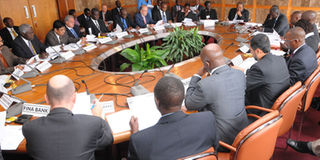Bank of Uganda increases lending rate

Bank of Uganda announced it would increase its key lending Central Bank Rate from 14.5 per cent to 16 per cent
What you need to know:
Currency. The move is meant to fight inflation
KAMPALA.
Loans are expected to continue getting more expensive as the Central Bank increases the rate at which it lends to commercial banks.
Yesterday, Bank of Uganda announced it would increase its key lending Central Bank Rate from 14.5 per cent to 16 per cent, citing inflationary pressures resulting from the continued weakness of the Shilling against the dollar.
The Shilling has since the start of this year lost its value by more than 32.6 per cent. To avert the Shilling crisis, Bank of Uganda has injected more than $220m (about Shs779.8b) on the money market.
In July this year, inflation rose from 4.9 per cent to 5.4 per cent but the Central Bank projects that it is likely to rise above 10 per cent in the next 12 months.
Addressing journalists in Kampala yesterday, the governor Bank of Uganda, Mr Emmanuel Tumusiime Mutebile, said: “There are several risks around the inflation outlook. These include the future path of the exchange rate, which will in part be influenced by external developments, and the speed at which the recent depreciation feeds through to higher inflation.”
Mr Mutebile said the current economic situation of the weak Shilling and high inflationary forces have warranted the Central Bank to reduce money in circulation with the view to keeping inflation within the 5 per cent target. 5.4 per cent inflation is already above the Central Bank target.
He said the risks coming from the global economic environment continue to adversely affect Uganda’s economic developments.
Ms Razia Khana, the Standard Chartered managing director for Africa global research, said the Central Bank’s move was a little surprising, given that the bank needs to proactively stabilise the foreign exchange market. Bank of Uganda explains that the country’s headline inflation rose for the fifth successive month in July 2015 to a 14-month high on the back of a broad based increase in price of services and other goods, except food-crop prices.
The move is likely to slow down economic growth from 6.2 per cent to 5 per cent and will put pressure on private sector credit growth as a result of an increase in commercial banks interest rates. Currently, banks are lending at an average of 22.4 per cent.
Dr Louis Kasekende, the deputy governor Bank of Uganda, said the tight monetary policy in place has seen less money in the domestic market leading to low uptake in treasury bills and bonds by bankers and other investors. The executive director of research Bank of Uganda, Dr Adam Mugume said if the Central Bank had not raised its key lending rate, inflation would have already risen to around 10 per cent.
“With the tight monetary policy in place we are going to witness slower rise in inflation, slight reduction in economic growth rate, contraction in private sector credit growth and a rise in the lending rate. However, economic activities will continue to be supported by public investment and foreign borrowing by government of Shs5.5 trillion,” he said.




